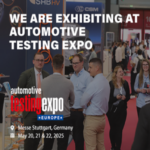From design to optimizing production processes, to validation, Cetim steps up to help automotive industry players meet the challenges of electric, hybrid and hydrogen-powered vehicles.
– Watch the video of our state-of-the-art equipment ! –
Emissions reductions are driving the automotive industry to reinvent itself! The car emissions target announced for 2050 of 23gCO2/km represents a reduction of nearly 90% compared to acceptable levels in 2005! Reaching this goal will take more than optimizing internal combustion engines. Going low-carbon means going electric. According to forecasts by Faurecia, the number of light vehicles with thermal energy engines, which represent 91% of all cars manufactured in 2019, will drop to 44% by the year 2030, replaced by hybrid, electric and hydrogen-powered vehicles.
For carmakers and motor vehicle equipment manufacturers, this shift involves sweeping changes. First, the necessary components like electric motors, batteries, hydrogen tanks, fuel cells and hydrogen combustion engines must be designed, standardized & manufactured, within a circular economy approach. In parallel, companies have to adapt their factories to produce a wider range of final products. “Since no single means of propulsion has asserted itself as the norm, carmakers must develop not only multi-model, but also multi-energy platforms,” declares Vincent Caulet, manager of the automotive and aeronautic markets at Cetim. To meet real-time demand, the same production line should be able to turn out thermal, electric, rechargeable hybrids or hydrogen-powered cars.
Cetim, partner of innovation
Long-term partner of Automotive Industry, Cetim has valuable skills and know-how to meet these challenges from design to validation to optimizing manufacturing processes. Its material analysis and characterization abilities, its eco-design, simulation and optimization software and its contact and contactless measuring methods can all be leveraged by industry players to develop new components.
Carmakers also turn to the expertise of the Centre to keep their factories up to speed. Vincent Caulet cites an example: “In early May, the Manufacturing division of a major carmaker entrusted us with several projects for increasing the performance and productivity of its machining at several European sites, in order to support the growing range of electric and hybrid vehicles.” In addition to ‘classic’ processes, the Centre also boasts solid experience and means in areas of growing importance to the automotive sector, like metal additive manufacturing and required component cleanliness.
Capitalizing on composites
Another important challenge is reducing weight. For several years, Cetim has been working on this through composite development, from QSD design, which optimizes component and parts design, to manufacturing with QSP processes (high speed thermoforming) and Spide TP (filament winding), to recycling with an R&D platform dedicated to thermoplastic composites at the Cetim Grand-Est facility. Composites are also a credible alternative to metals for making recyclable hydrogen storage tanks. The Centre is currently carrying out studies on this subject with a major equipment manufacturer. Its facilities boast a burst containment pit for testing the mechanical strength of this type of tank under very high pressure (up to 4,800 bars of water pressure).
The challenge of validation
“Taking into account the various models and motor types, there is a huge number of components to be validated,” Vincent Caulet points out. “Cetim handles most of these elements with perfectly adapted test resources.” Starting with the electric powertrain. The Centre has, for example, developed a test stand for high-speed gearboxes (20000 t/min) and high power automotive applications (up to 250 kW). Its mission: validating front and rear high-speed gearboxes, lubricants and materials for new generation hybrid and electric vehicles. The Centre also has three electric motor “rotor endurance” test stands and four transmission (gearboxes and low-speed gear reducers) validation stands, as well as performing post-test component default analysis.
In Mulhouse (France), Cetim Grand Est works on other types of components: additional heating systems for car interiors or thermal management systems for batteries for electric and hybrid vehicles. “Our testing facilities are equipped to perform multi-physical tests that combine environmental factors (vibrations, temperature, humidity, salt contamination) and vehicle operation (voltage, current, temperature increase, contact resistance, etc.) to get continuously closer to real usage conditions,” boasts Laurent Minnig, director of Cetim Grand Est.
Finally, the chassis and its components are significantly impacted by the multiplication of vehicle types. “We must provide support for batteries on some models, for engines of varying weight on others… while the mass is distributed differently and different constraints apply depending on the vehicle type,” explains Marc Zandona, director of the Senlis site. “To validate these components, we have several test stands including 2 so-called “6 axis” models able to reproduce various usage scenarios and charge cycles.”
Increasingly efficient means and methods
This arsenal of tests is growing constantly. To provide support to carmakers in their quest for reducing mechanical friction – in order to improve powertrain performance – “we have invested in a bearing drag measurement system, slated for launch by year-end 2021,” says Vincent Caulet.
The next step? Smart Testing: leveraging BigData to enhance testing, reducing the number and duration of test campaigns by processing collected data, cross-referencing it with the Centre’s internal data bases (materials, testing, etc.). The objective is clear: reduce validation times and bring tested innovations to market more quickly.
Watch the video of our dedicated equipment ! The Centre boasts numerous test stands, including one for testing front and rear high-speed gearboxes for new generation hybrid and electric vehicles.
Meet us at SIA POWERTRAIN 2021!
For more information, please contact sqr@cetim.fr or visit our dedicated web page.
Article from Cetim Info N°256 – May 2021 Issue



